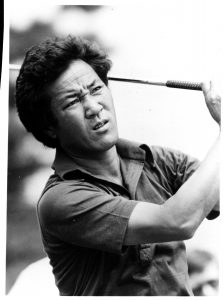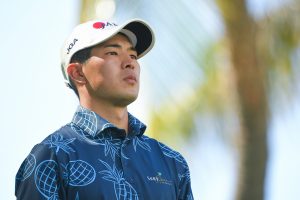
Hideki Matsuyama of Japan celebrates with the Sony Open trophy in 2022. (Photo by Cliff Hawkins/Getty Images)
Japan fondly refers to Hawaii as the “Islands of Everlasting Summer” and each January, in the dredges of the cold Japanese winter, a select number of Japanese native professional golfers make their way to the world-famous holiday isle to compete in the Sony Open in Hawaii.
While the naming of the tournament has changed over time, the event itself has a rich Japanese history dating back nearly a century when in 1929, two players, Tomekichi Miyamoto and Kōkichi Yasuda became the first-ever from Japan to play in a PGA TOUR event at the then Hawaiian Open.

Other well-known Japanese had gone on to play in the event after that, but in 1983, the tournament would be solidified in Japanese lore when it delivered Japan and Asia’s first PGA TOUR winner in Isao Aoki who came away triumphant when he holed out for an amazing eagle 3 on the 18th hole to beat Jack Renner by a stroke, a miraculous shot that would be remembered for years to come as one of the greatest of all time.
For Sony, since taking over the title sponsorship of the tournament in 1999, giving back to the local Hawaiian community has always been a core concept of the Sony Open with the tournament now producing over US$1.2 million annually for charity, benefiting more than 100 not-for-profit organizations each year and has raised US$24 million total for over 350 local charities.
While giving back to the Hawaiian community is important, Sony has also found ways to support its native Japan as well.
“We wanted to do something special for young Japanese golfers to help them become successful internationally,” said Hiroshi Kawano, Executive Vice President of Sony Corporation who is in charge of Sony Open in Hawaii. “We wanted to give these young players an opportunity to help them achieve their dreams because they are the ones that will make up the future.”
The idea of providing a platform and the opportunity for these players to succeed originated in 2010 when Hideki Matsuyama first qualified to play in the 2011 Masters Tournament after winning the 2010 Asia-Pacific Amateur Championship.
Matsuyama was a freshman at Tōhoku Fukushi University at the time, and Sony felt that Hideki’s lack of professional playing experience on the PGA TOUR may prove to be too difficult to overcome when it came to competing in the forthcoming Masters Tournament and offered him a sponsor exemption into his first PGA TOUR tournament to help him get a feel for what it was like to play on tour.
Sony’s theory proved successful where at the 2011 Masters Tournament, Hideki would go on to become the first Japanese amateur to win the Silver Cup, an award presented to the lowest scoring amateur.
Sponsor exemptions into Sony continued to be extended to Matsuyama over the next two years and after turning pro in 2013 and gaining his full-time PGA TOUR card for 2014, Hideki finished the 2014 season with 12 top-25 finishes and would go on to win his first TOUR win at the Memorial tournament that same year.
Following in the footsteps of the elder Matsuyama, many other young amateurs, including Takumi Kanaya and Keita Nakajima, who like Hideki were members of the Japan national team and recipients of the McCormack medal, which is awarded to the world’s top ranking amateur, also received exemptions into the Sony Open as amateurs.
Kanaya’s first appearance was in 2019 where he fell just short of making the cut but came away with the priceless experience of playing amongst the world’s best.
“Having the opportunity to play in the Sony Open while I was still in university had a huge impact to my career,” said Kanaya. “Getting the chance to play with players such as Corey Conners and other successful PGA TOUR members not only showed me what professional golf was like at that level but helped me identify where I needed to practice and improve my own game.”
Sony will typically extend their four sponsor exemptions to other Japanese and Asian players each year but in the wake of Matsuyama’s success on TOUR and in an effort to continue helping up-and-coming Japanese stars like Kanaya, Nakajima, Rikuya Hoshino, Kaito Onishi and others, Sony would go on to create a dedicated player exemption program called the Sony Open Challenge.
When Sony Group Corporation renewed their title sponsorship with PGA TOUR in 2021, they formalized a pathway for Japan Golf Association’s top-ranked amateur and Japan Golf Tour’s top-ranked professional to receive an automatic exemption into the Sony Open each year through 2026.

The first recipient of this newly established exemption category was the No. 1 amateur in the world, Keita Nakajima, who like Matsuyama would make his own PGA TOUR debut at the 2022 Sony Open via the Sony Open Challenge.
The performance by Keita alone that week, where he finished a creditable 41st, validated the newly established Sony Open Challenge, and the young 21-year-old subsequently found himself standing greenside on the 18th hole watching a playoff between his idol, Hideki Matsuyama and Russell Henley. Matsuyama would hit one of the all-time shots in Sony Open history, nearly matching what Aoki had accomplished almost 39 years to the day, with a towering 3-wood from 276 yards which landed two feet on the par-5 18th for a winning eagle putt.
“I have no words, I’m speechless,” said Nakajima as he watched in awe over Matsuyama’s accomplishment.
Everything had come full-circle for Matsuyama where in the tournament that had given him the opportunity to play in his first PGA TOUR event as a 17-year-old amateur, he was now the champion.
“I finally won it”, a relieved Matsuyama told Sony’s Kawano after the tournament.
The system instilled by Sony to help create the next generation of great Japanese golfers was already paying dividends which is ever-present still today with a star-studded list of Japanese exemption players trying to make a name for themselves in a tournament already steeped in Japanese history.

“Sony Open is the only tournament that provides this kind of playing opportunity to Japanese golfers. They have helped give me the chance of reaching my own dream of one day playing on the PGA TOUR and I believe the experience of playing here last year helped sharpen my game enough both mentally and physically to help me win two times last year on JGTO,” said Taiga Semikawa who finished No. 1 on the 2023 JGTO Mercedes-Benz total point rankings.
Semikawa is also back in the field this year under a sponsor exemption along with Kanaya, Aguri Iwasaki, Yuto Katsuragawa and Kensei Hirata, with Rintaro Nakano receiving the amateur exemption spot.
This will be the last year for Kawano to oversee the operation of the Sony Open in Hawaii as he moves into retirement, but when asked about what kind of legacy he hoped to leave behind, he was quick to respond saying that, “Creating a system to help young players achieve their dreams is the value I have added and I hope my successor will find the next layer to the original idea I helped create.”
Only time will tell, but with a strong contingent of young Japanese stars being led by PGA TOUR’s winningest Asian-born golfer in Hideki Matsuyama, the future is in good hands with opportunities to prove themselves at the Sony Open in Hawaii.

